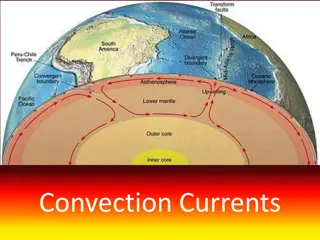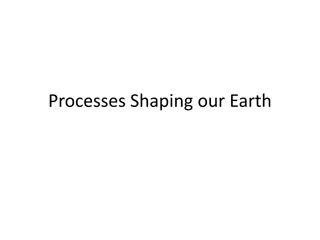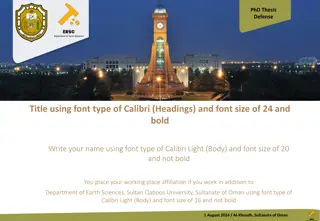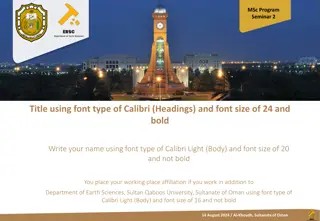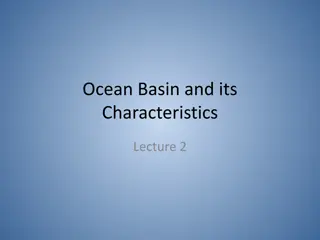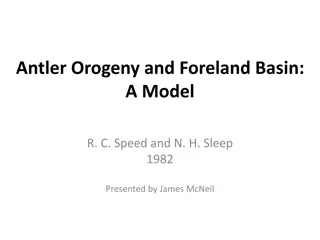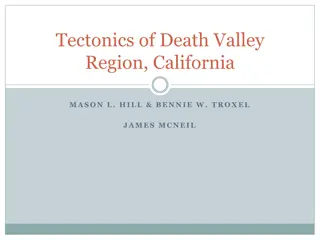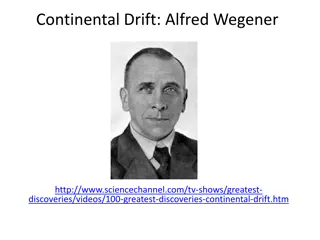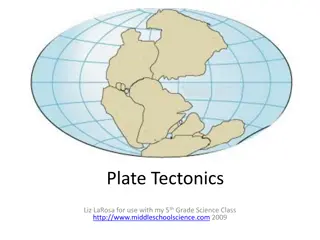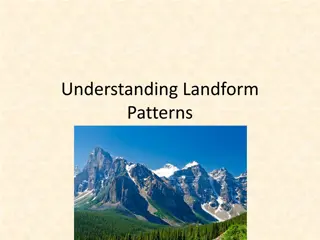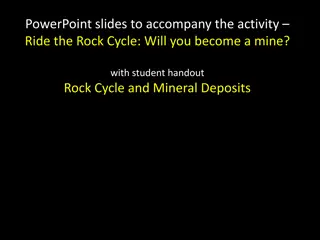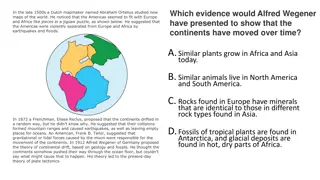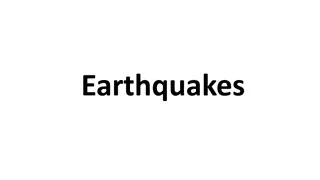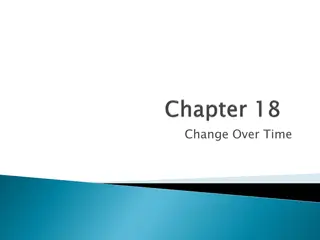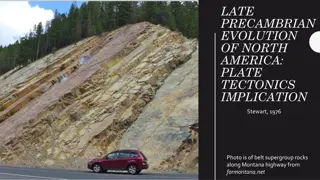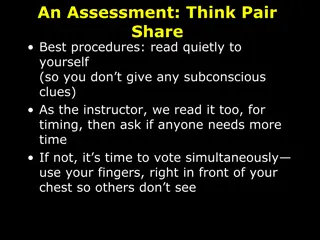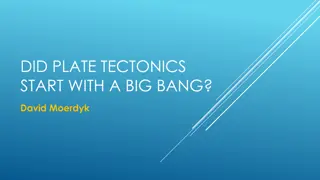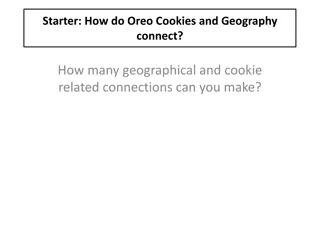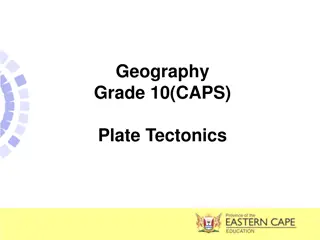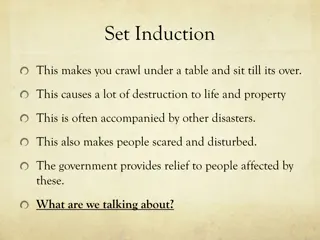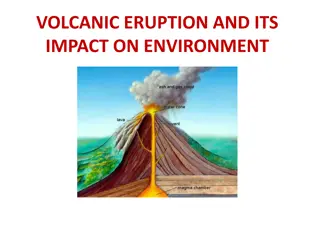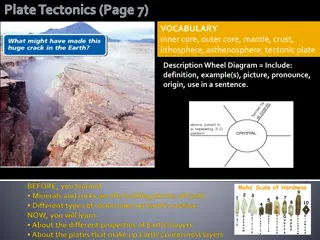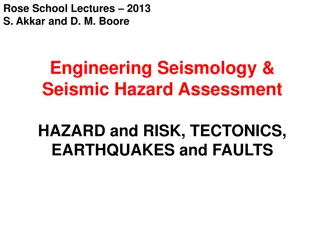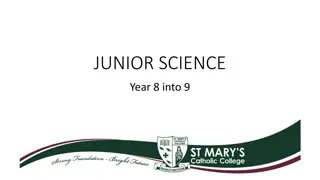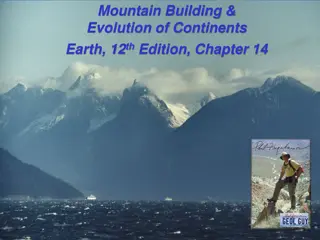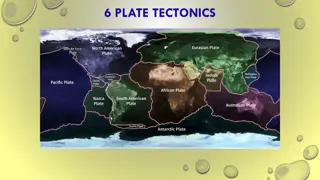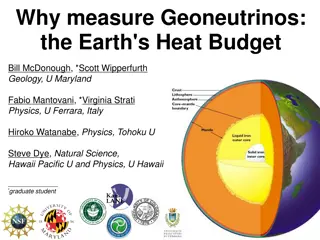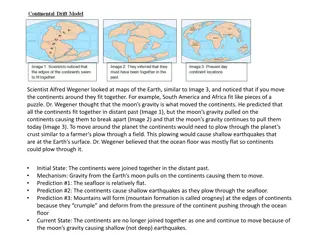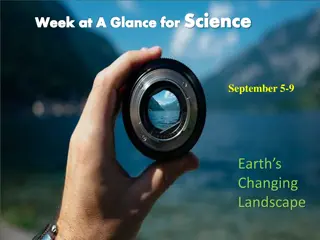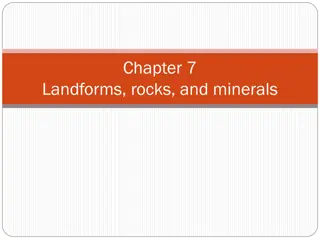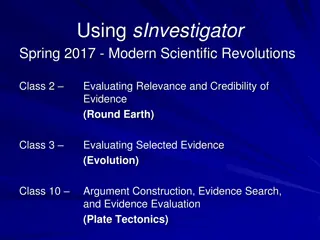Geology of Ogun State, Nigeria: Insights and Implications
The geology of Ogun State in southwestern Nigeria, particularly within the Dahomey or Benin Basin, holds significant value for understanding the region's origins and geological evolution. This includes insights on sedimentary basins, the Wilson Cycle, and the unique characteristics of the Dahomey or
3 views • 35 slides
Understanding Plate Tectonics: Meaning, Concepts, and Plate Margins
Plate tectonics is a scientific theory explaining the movement of Earth's lithospheric plates. Developed by various scientists, it involves the drifting of plates over the Earth's surface, leading to phenomena like earthquakes and mountain formation. The theory is based on continental drift and sea-
5 views • 7 slides
Understanding Convection Currents in Earth's Systems
Convection currents refer to the movement of heat by fluids like liquids and gases, transferring heat from one place to another. They play a significant role in the geosphere, atmosphere, and hydrosphere of the Earth, influencing phenomena such as plate tectonics, winds, and ocean currents. In the g
0 views • 12 slides
Understanding Processes Shaping Earth: Lithosphere, Plate Tectonics, and Effects
Explore the components of our planet, such as the lithosphere, hydrosphere, atmosphere, and biosphere. Learn how the lithosphere, consisting of the Earth's crust and top solid mantle, interacts through plate tectonics, causing movements that shape the Earth's surface. Discover the concept of Pangaea
0 views • 31 slides
PhD Thesis Defense - Tectonics and Stratigraphy Study in Earth Sciences
This PhD thesis defense focuses on tectonics, stratigraphy, and depositional environments in Earth Sciences, specifically in the Sultanate of Oman. The research background, objectives, study area, dataset, methodology, and preliminary results will be presented and interpreted. The main objective is
0 views • 10 slides
Seminar on MSc Program Research in Earth Sciences at Sultan Qaboos University
Seminar presentation featuring research conducted in the MSc Program at Sultan Qaboos University focusing on tectonics, stratigraphy, and depositional environments. The study aims to achieve XYZ by presenting background, objectives, methodology, results, and conclusions. Date: 14 August 2024, Locati
0 views • 10 slides
Visualizing Relationships with Data: Earthquakes, Volcanoes, and Plate Tectonics
Explore the locations of earthquakes and volcanoes to understand plate boundary zones, compare plate motion in different regions, and determine plate boundary zones using various data sources. Follow step-by-step instructions to study maps, analyze earthquake and volcano distributions, and engage in
0 views • 37 slides
Understanding Ocean Basins and Their Characteristics
Ocean basins are vast submarine regions that cover a significant portion of the Earth's surface, hosting the majority of the planet's water. These basins exhibit various features such as ocean ridges, deep-sea trenches, and seismic ridges. The ocean floor is constantly evolving due to plate tectonic
0 views • 18 slides
Antler Orogeny and Foreland Basin Model Overview
The Antler Orogeny, a Late Devonian to mid-Early Mississippian event, impacted the passive margin of the North American continent, particularly in Nevada and Idaho. The orogeny involved displacement of oceanic strata, subsidence of a foreland basin, and maintenance of highlands in the interior regio
1 views • 14 slides
Comprehensive AP Environmental Science Study Guide
Covering a wide range of topics including Earth Systems and Resources, The Living World, Population, Land and Water Use, Energy Resources and Consumption, Pollution, and Global Change, this study guide provides detailed information on geologic time scales, plate tectonics, atmospheric composition, w
0 views • 168 slides
Plate Tectonics: Evolution of the Earth
Explore the dynamic process of plate tectonics shaping the Earth's crust through the movement of tectonic plates, subduction zones, divergent and convergent boundaries. Discover how seafloor spreading creates new oceanic crust, and learn about the geological features formed by these processes.
0 views • 25 slides
Tectonics of Death Valley Region, California: A Geological Study
This study delves into the intricate tectonic processes of the Death Valley region in California, focusing on strike-slip and dip-slip fault systems, tensional and compressional stress, and the implications of NE-SW horizontal shortening and NW-SE relative extension. It explores the unique features
0 views • 10 slides
The Theory of Continental Drift: Alfred Wegener and Pangaea
Alfred Wegener proposed the theory of continental drift, suggesting that the continents were once part of a single landmass called Pangaea. Evidence such as fossils and rock formations on different continents supports this theory. The concept of plate tectonics further explains the movement of conti
0 views • 6 slides
Exploring Plate Tectonics and Earth's Structure for 5th Grade Science
Delve into the world of plate tectonics with a focus on Earth's layers, crust, mantle, and core. Understand how tectonic plates move and learn about continental drift and the concept of Pangea. Explore evidence of Pangea, sea floor spreading, and the fascinating geological processes that shape our p
0 views • 23 slides
Unveiling Earth's Landform Patterns Through History
Explore the fascinating journey of Earth's landforms, from the formation of continents to the theory of Plate Tectonics. Delve into the rich history of geology, uncovering insights from notable scientists like James Hutton and Alfred Wegener. Witness the dynamic processes of earthquakes, volcanoes,
0 views • 52 slides
Exploring the Intricacies of the Rock Cycle Through Interactive Activities
Dive into the fascinating world of rocks and minerals with the engaging activity "Ride the Rock Cycle: Will you become a mine?" This game-based approach allows students to visualize and comprehend the complexity of the rock cycle, appreciate plate tectonics, understand the rarity of economically val
0 views • 16 slides
Understanding Plate Tectonics and Earth's Crust
Explore the differences between oceanic and continental crust, the distinctions of lithosphere and asthenosphere, the dynamics of convergent and divergent boundaries, as well as the concepts of folding and faulting in geological formations. Delve into the characteristics of oceanic crust versus ocea
0 views • 10 slides
Understanding Earth's Structure and Continental Drift Theories
Dutch mapmaker Abraham Ortelius noted the jigsaw fit of continents, leading to the theory of continental drift. Alfred Wegener proposed the movement of continents based on geological evidence, influencing plate tectonics theory. Earth's layers vary from the thick mantle to the solid inner core due t
0 views • 27 slides
Geography Homework: Exploring the Middle East in Year 8
Explore the captivating world region of the Middle East in this Year 8 geography homework booklet. From matching capitals to countries and understanding the importance of diversification, to delving into the physical geography, climate, and population changes of the region, this booklet offers a com
0 views • 15 slides
Understanding Earthquakes and Seismic Waves
This lecture delves into the nature and origin of earthquakes, discussing seismic waves, measurement techniques, effects of earthquakes on various Earth systems, and the relationship between earthquakes and plate tectonics. The content touches on topics like the impact of earthquakes on biosphere, h
0 views • 34 slides
The Theory of Plate Tectonics: Continents in Motion
Earth's crust and lithosphere have changed over geologic time, forming tectonic plates that move due to convection currents. The concept of plate tectonics explains how continents fit together, the existence of a supercontinent called Pangaea, and natural phenomena like earthquakes and mountains. Ea
0 views • 28 slides
Understanding Scientific Concepts: Theories, Laws, and More
Explore the interconnected concepts of scientific theories and laws, including examples such as Newton's 2nd Law of Motion, the Theory of Plate Tectonics, and more. Delve into the definitions of facts, hypotheses, theories, and laws to enhance your understanding of the scientific world.
0 views • 25 slides
Evolution of North America's Rocks: Plate Tectonics Influence
Late Precambrian rocks in North America underwent a transition from belt supergroup rocks deposited in intracontinental basins to miogeoclinal rocks along the continent margins. This change was attributed to plate tectonics, with significant deposition in cratonic basins and edges. The shift at 850
0 views • 8 slides
Plate Tectonics and Boundaries Overview
The content discusses various aspects of plate tectonics and boundaries, including the best procedures for assessments, features at convergent and divergent boundaries, the movements of ocean plates relative to islands, identifying plate boundaries on a map, and reasons for the delay in accepting pl
0 views • 7 slides
Unraveling Plate Tectonics: Impact of Earth's Geological Formations
Exploring the intricate relationship between plate tectonics and significant geological events such as Permian-Triassic extinctions, lava eruptions, and bolide impacts. Delve into the origins of Earth's tectonic movements and their profound impact on the planet's history.
0 views • 28 slides
Exploring the Connection Between Plate Tectonics and Oreo Cookies
Discover the unique ties between plate tectonics and Oreo cookies through a creative exploration of tectonic plate boundaries using Oreo cookies as a tangible model. Learn about the structure of the Earth, types of plate boundaries, and the movement of tectonic plates in a hands-on and engaging mann
0 views • 15 slides
Understanding Plate Tectonics and Earth's Surface Features
The study of plate tectonics reveals how the Earth's crust is divided into tectonic plates, leading to various types of plate boundaries like divergent, convergent, and transform. These movements result in earthquakes, volcanic eruptions, and landform changes such as folding and faulting. Different
0 views • 15 slides
Understanding Earthquakes and Plate Tectonics
Rapid Earth Movement, specifically earthquakes, is a natural disaster causing destruction and fear. Plate tectonics play a crucial role in the occurrence of earthquakes and volcanoes. The movement of Earth's plates at plate boundaries results in different geological features like fold mountains. Thi
0 views • 36 slides
Understanding the Impact of Volcanic Eruptions on the Environment
Explore the causes of volcanic eruptions, including pressure changes, radioactive minerals, plate tectonics, hot spots, earth movement, thermal contraction, and water's role. Learn about different types of volcanicity and the landforms created by both extrusive and intrusive volcanic activity, from
0 views • 20 slides
Earth's Layers and Plate Tectonics Overview
Earth's layers, including the core, mantle, and crust, have different properties and compositions that shape the planet's structure. Scientists study seismic waves to understand Earth's interior. Plate tectonics play a crucial role in shaping the planet's surface features through the movement of lit
0 views • 13 slides
Engineering Seismology & Seismic Hazard Assessment Lectures Overview
This content provides detailed information on the Rose School Lectures 2013 by Sinan Akkar and D. M. Boore focusing on Engineering Seismology & Seismic Hazard Assessment. It includes course schedules, instructor details, contact information, and online software used. Topics covered range from hazard
0 views • 10 slides
Science Curriculum Overview for Year 8 to Year 10 Students
Year 8 to Year 10 Science curriculum covers a range of topics including Biology, Chemistry, Earth Science, and Physics. Students engage in experiments, research investigations, and data analysis. Year 9 topics include ecosystems, atomic structure, plate tectonics, light, and electricity. In Year 10,
0 views • 7 slides
Understanding Mountain Building and Evolution of Continents
Mountain building, orogeny, and the formation of major mountain belts are key processes in the evolution of continents. This chapter delves into the geological mechanisms behind these phenomena, focusing on convergent boundaries, the American Cordillera, Alpine-Himalaya chain, and other significant
0 views • 50 slides
Exploring Plate Tectonics and the Scientific Method
Dive into the world of plate tectonics and the scientific method in this lesson. The session covers vocabulary and grammar review, giving and receiving feedback, learning new concepts related to plate tectonics, and understanding participles and participial adjectives. Explore the theory of plate te
0 views • 8 slides
Geoneutrinos and Earth's Thermal Power Budget Analysis
Geoneutrinos play a crucial role in understanding the Earth's heat budget. Researchers like Bill McDonough and others utilize geoneutrino studies to investigate radioactive decay driving the Earth's internal processes, mantle convection, plate tectonics, and more. By measuring geoneutrinos, valuable
0 views • 12 slides
The Theory of Continental Drift and Plate Tectonics
Scientist Alfred Wegener proposed the theory of continental drift, noticing how continents could fit together like pieces of a puzzle. His idea evolved into the concept of plate tectonics, explaining the movement of Earth's lithosphere. This model highlights the dynamic nature of the Earth's surface
0 views • 4 slides
Science Week at a Glance: Earth's Changing Landscape - September 5-9
Explore the dynamic processes shaping Earth's surface through a week-long science program. Dive into topics like the formation of Earth's surface, rock classification, plate tectonics, mineral characteristics, and fossil evidence of our planet's history. Engage in hands-on activities, discussions, a
0 views • 10 slides
Exploring Earth's Changing Landscape Through Science
Dive into a week-long study of Earth's surface and composition through the lens of science. From investigating the layers of the Earth to understanding plate tectonics and the rock cycle, students will explore how geological processes shape our planet. Engaging activities such as hands-on experiment
0 views • 10 slides
Understanding Earth's Changing Crust: Landforms, Rocks, and Minerals
The Earth's crust is in constant motion due to plate tectonics, which results in various landforms, rocks, and minerals. This movement is driven by forces such as tension, compression, and shear, causing earthquakes, mountains, and volcanic activity. Through processes like weathering and erosion, th
0 views • 26 slides
Mastering Evidence Evaluation in sInvestigator Spring 2017
Dive into the world of evidence evaluation using the sInvestigator tool in the Modern Scientific Revolutions class. Explore topics like Evolution and Plate Tectonics, learn to assess relevance, credibility, author competence, and more through practical exercises. Enhance your understanding of scient
0 views • 17 slides


